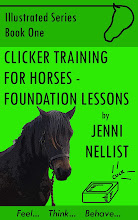Using the clicker as a training tool is something I've really enjoyed doing for quite a number of years now, and sometimes it's hard for me to understand why anyone wouldn't want to.
http://www.youtube.com/watch?v=1Oy7eBOFaE4
There are differences between using the clicker to train horses and using more traditional or natural horsemanship methods. With the latter we tend to stimulate the horse to perform some behaviour via means of our own actions. We prefer the horse not to do behaviour unless prompted by us. Unwanted behaviour is normally corrected, or more accurately termed, 'punished' by a swift verbal or tactile reprimand.
With the clicker things are different. We, as the trainer, are more passive and instead look for the horse to offer behaviour that we can capture. By 'capture', I mean signal to the horse in the instant that the specific behaviour is being performed that their behaviour has earned them a reward, usually a food titbit. The signal is usually the clicker noise, but it could be another easily perceptible signal, that has previously been associated with the titbit. The horse learns that that click announces food, and any behaviour that the horse can do that makes that happen is normally repeated fairly frequently!
When unwanted behaviour occurs during clicker training it does not normally meet any sort of interuption - unless lives really are at risk! Instead the unwanted behaviour fails to get any sort of reinforcement. Behaviour that fails to earn clicks and treats normally dissappears from the repertoire, but if the worst comes to the worst, incompatible behaviour can be trained to take the place of unwanted behaviour.
My latest example is pawing with the forelimb. This behaviour is normally rooted in frustration at not getting food when the horse expects that it should - after all, horses paw snow covered ground to get the grass beneath, it's a natural instinctive response to frustration. It may also occur when the horse is frustrated in other ways and can't solve the problem in the manner it would like. In this case pawing isn't really appropriate because it won't work to solve the problem. But nevertheless, it is an instinctive, unconscious response to feeling highly frustrated and relatively helpless - but not helpless enough to become shut down and inhibited. In this context, such inappropriate behaviour is referred to as 'displacement' behaviour.
One of my customer's horse's expressed pawing behaviour during training with a more traditional trainer. The behaviour was reprimanded either by a verbal correction, or by jolting the lead rope attached to the horse. The behaviour didn't decrease in frequency until the horse was performing other, incompatible behaviour under direction of the trainer, and therefore was not effectively punished as these reprimands failed to completely inhibit pawing.
This session compared to a more recent session with clicker training was interesting. The session with the traditional trainer had seemed to set a precedent for increased pawing behaviour, something we'd not been seeing recently in our sessions, but it by the most recent session it had made quite the comeback! So, as we were clicker trianing we ignored it - while taking care not to stand in front of the offending forelimbs! Instead we shaped standing still behaviour, in order to set up for new tasks inspired by our traditional trainer. Pawing no longer got any pay off, not even attention - it must be remembered that looking at and speaking to horses when reprimanding them does constitue attention, even if it's not exactly the quality the horse might want. Standing still did get a pay off, and so the horse became confident in performing this behaviour and able to offer further behaviour for us to capture.
So what's the moral of this story? To get into clicker training it may be necesary to let go of ideas about inhibiting behaviour, and to accept that horses can offer behaviour and that we can increase the likliehood of certain offered behaviour by clicking and treating it, and lose behaviour we don't want by ignoring it, and training incompatible behaviour in its place.
Want to know more about clicker training? Why not see my website for a presentation near you?
www.jenninellist.co.uk
Subscribe to:
Post Comments (Atom)


Let me just critique one point; never ever ever ignore behaviour you don't like. Attend closely so that you can reinforce an alternative. If you are telling people to ignore behaviour, they will hear ignore the horse...dog....rabbit...or whatever.
ReplyDeleteSue